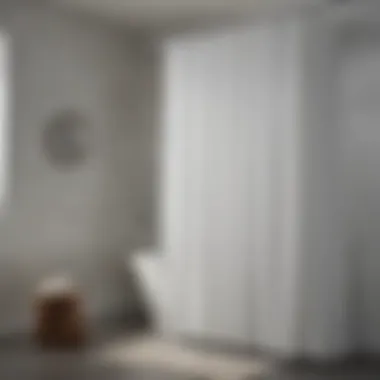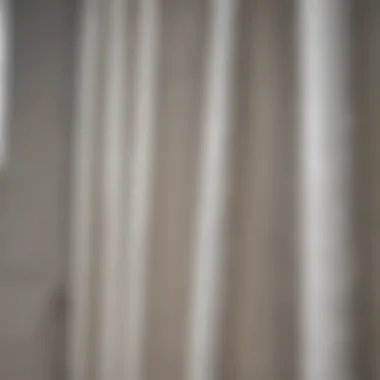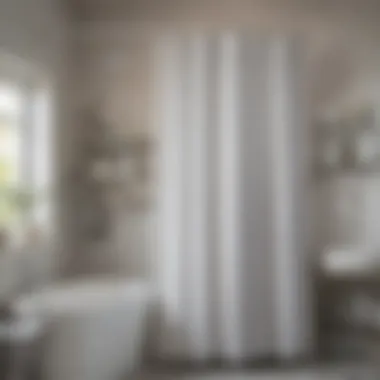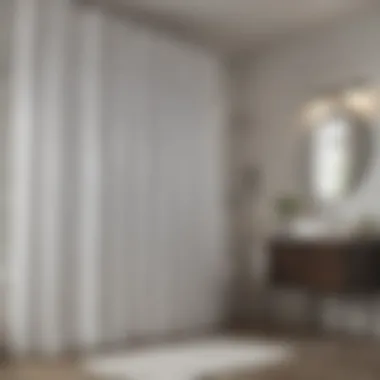Vinyl Plastic Shower Curtains: A Comprehensive Examination


Intro
Vinyl plastic shower curtains are a staple in many bathrooms today. Their popularity arises from a blend of functional advantages and aesthetic appeal. This article delves deeply into the various aspects of these curtains, offering insights into their materials, designs, benefits, shortcomings, and maintenance. We aim to explore why they continue to remain relevant in contemporary home decor while addressing any potential health implications associated with their use. This comprehensive examination will equip consumers and industry professionals alike with the knowledge needed to make informed decisions when selecting shower curtains for their bathrooms.
Overview
Vinyl shower curtains typically consist of polyvinyl chloride (PVC), a type of plastic known for its flexibility and durability. These curtains come in a variety of styles, colors, and patterns, making them suitable for numerous bathroom designs. They provide a practical solution for water containment while simultaneously enhancing the visual aesthetics of the space.
Key Points to Discuss
- Materials: What goes into making vinyl plastic shower curtains?
- Designs: Different design choices available.
- Advantages: Why choose vinyl over other materials?
- Disadvantages: Potential downsides of vinyl curtains.
- Maintenance Tips: How to prolong the life of your shower curtain.
- Environmental Implications: Considerations related to vinyl production and disposal.
- Health Considerations: Are there any risks associated with vinyl?
- Selection Criteria: Factors to consider when buying.
By covering these essential points, this examination aims to provide an all-encompassing understanding of vinyl plastic shower curtains, catering to those who appreciate the interplay of design and function in their home spaces.
Preface to Vinyl Plastic Shower Curtains
Vinyl plastic shower curtains hold a significant place in modern bathroom design. They are not just a functional element; they also serve aesthetic and practical purposes. With various designs and materials available, understanding their importance can help consumers make informed choices. This section highlights crucial elements, benefits, and considerations regarding vinyl plastic shower curtains.
Definition and Purpose
Vinyl plastic shower curtains are made from polyvinyl chloride (PVC) or similar synthetic materials. Their primary purpose is to create a barrier between the wet environment of the shower and the rest of the bathroom. This helps in preventing water damage to walls and floors. Additionally, vinyl curtains are often chosen for their durability and water resistance, making them ideal for daily use.
Aside from function, these curtains can contribute to the overall style of a bathroom. With various colors, patterns, and designs, they can complement different themes, from minimalist to bold. Many people appreciate the convenience of vinyl plastic because of its lightweight and easy installation. However, potential buyers should consider maintenance and environmental implications when making their selection.
Historical Context
The history of shower curtains extends back to the earliest days of indoor plumbing. Before vinyl, materials such as cotton and linen were prevalent. These fabrics provided some coverage but were not waterproof. As the need for more effective bathroom solutions grew, the development of vinyl in the mid-20th century marked a turning point.
In the 1960s and 1970s, manufacturers began producing vinyl shower curtains because of their water-resistant properties and affordability. This innovation made shower curtains accessible to a broader audience, leading to their wide adoption in households. Since then, trends in vinyl curtain design have evolved, reflecting changes in consumer preferences, design aesthetics, and environmental concerns. Today, vinyl remains a popular choice, though it is essential to note the growing market for alternative materials.
Materials and Construction
The materials and construction of vinyl plastic shower curtains are crucial factors determining their success and viability in consumer markets. Understanding these components can help buyers make informed choices that meet their needs and preferences. This section discusses the composition of vinyl plastic and the various methods of manufacturing, highlighting the significance of these elements in the production of shower curtains.
Composition of Vinyl Plastic
Vinyl plastic, primarily made from polyvinyl chloride (PVC), is widely used for shower curtains due to its specific properties. PVC is a synthetic polymer known for its versatility and durability. The production of vinyl plastic involves the polymerization of vinyl chloride monomers, resulting in a compound that is both water-resistant and flexible.
Benefits of PVC
- Water Resistance: The inherent properties of PVC make it an excellent barrier against water, preventing leakage and protecting the underlying surfaces.
- Longevity: Vinyl shower curtains can withstand the wear and tear of daily use, which extends their lifespan compared to non-plastic alternatives.
- Easy to Clean: This material is simple to wipe down, which enhances hygiene in wet environments like bathrooms.
However, there are concerns regarding the environmental impact of PVC production, as it involves hazardous materials and generates toxic emissions during manufacturing.
Manufacturing Processes
The manufacturing process of vinyl plastic shower curtains involves several key steps, each contributing to the final product's quality and functionality. Understanding these processes can inform buyers about what to expect regarding production standards and potential variations in curtain performance.
- Mixing and Compounding: Raw materials are mixed with additives, such as stabilizers and plasticizers, which improve flexibility and durability over time.
- Calendering: In this process, the mixed blend is passed through heavy rollers to produce sheets of vinyl at specific thicknesses. This step ensures uniformity and consistency in material properties.
- Cutting and Seaming: Once the sheets are produced, they are cut into desired sizes and shapes. Seams are typically heat-sealed to maintain water resistance and structural integrity.
- Printing and Finishing: Patterns and designs are printed onto the curtains. This may involve customizations depending on market demands. Finally, the shower curtains are inspected for quality before packaging.
"Understanding the manufacturing process can help consumers discern between high-quality and lower-quality vinyl shower curtains, thus aiding in the selection of the best products for their homes."


Through these manufacturing practices, producers strive to create vinyl plastic shower curtains that meet consumer expectations while balancing durability, aesthetic appeal, and cost-effectiveness. Nevertheless, as consumers become increasingly conscious of environmental issues, the industry may evolve to adopt more sustainable practices in both materials and methods.
Design Trends
Design trends for vinyl plastic shower curtains plays a key role in their enduring appeal. As interiors evolve, consumers seek more than just functionality in their bathroom accessories. The aesthetics of a shower curtain can greatly impact the overall look and feel of a bathroom. It's not only about keeping water inside the shower, but also providing a pleasing visual element that enhances the space.
Color Variations
Color variations offer consumers a wide range of choices. Vinyl plastic shower curtains are available in an array of colors, from vibrant shades to subdued tones. Bright colors like aqua blue or sunny yellow can energize a bathroom, while muted colors such as beige or gray can create a calming atmosphere.
When selecting a color, consider the overall color scheme of your bathroom. A striking contrast can serve as a focal point, drawing attention to the shower area. Additionally, lighter colors can make a small space feel larger and airier. Some popular color combinations include monochromatic designs and complementary shades.
"A well-chosen color can redefine the entire ambiance of a bathroom, making it both functional and stylish."
Patterns and Textiles
Patterns on vinyl plastic shower curtains have also seen significant growth in popularity. Geometric shapes, floral designs, and abstract art contribute to the visual diversity in the market. These patterns allow consumers to express their personal style. For instance, a floral design may evoke a vintage feel, while geometric patterns can align with modern minimalism. Textural details, such as embossed or matte finishes, can add depth to a basic design.
Moreover, patterns can assist in hiding water spots and soap residue, which can be advantageous for maintenance. It is crucial, however, to choose a design that not only resonates with personal taste but also complements the existing decor.
Customization Options
Customization is another significant trend in vinyl plastic shower curtains. Many brands now offer personalized designs, allowing consumers to select specific patterns, colors, or even print their images. This trend reflects a broader desire for individuality within home decor.
Customization can enhance the decorative quality of a bathroom. For example, families may choose to print their name or a family photo on the curtain. It provides a sense of ownership and uniqueness to the space.
Advantages of Vinyl Plastic Shower Curtains
Vinyl plastic shower curtains are popular among consumers for various compelling reasons. Their appeal lies in a combination of practical benefits. By looking at the advantages, one can gain insight into why these shower curtains continue to be a staple in many homes.
Water Resistance
One of the most significant benefits of vinyl plastic shower curtains is their water resistance. These curtains are designed to repel water effectively, preventing mildew and mold formation. This feature is essential in a bathroom where moisture levels can be quite high. Homeowners often find that vinyl curtains dry quickly after a shower, reducing the chances of water damage to surrounding areas. Additionally, the water-resistant nature keeps them clean for longer periods, requiring less frequent washings compared to fabric alternatives.
Affordability
Cost-effectiveness also plays a crucial role in the decision-making process for many consumers. Vinyl plastic shower curtains are generally more affordable than their fabric counterparts. This affordability does not equate to a compromise in quality, as these curtains are readily available in diverse styles and designs. A budget-conscious buyer can find a vinyl curtain that fits their aesthetic preferences without overspending. This accessibility makes them appealing to a wide range of consumers looking to enhance their bathroom’s functionality without breaking the bank.
Durability
Vinyl plastic shower curtains are known for their durability. Made from robust materials, they are less prone to tearing or failing under normal usage scenarios. Unlike fabric curtains, which can wear out from washing and exposure to water, vinyl options can last several years with proper care. They resist fading from sunlight and maintain their vibrant colors over time. This longevity ensures that they provide value over the long term, reducing the need for frequent replacements.
"Vinyl shower curtains can withstand wear and tear for many years, making them a wise investment for any bathroom."
In summary, the advantages of vinyl plastic shower curtains include their water resistance, affordability, and durability. Understanding these factors can guide consumers in making informed decisions. As such, vinyl remains a popular choice for modern bathrooms.
Disadvantages of Vinyl Plastic Shower Curtains
Vinyl plastic shower curtains are popular for their affordability and water resistance. However, they also come with several disadvantages that deserve attention. Understanding these drawbacks helps consumers make informed decisions when choosing shower curtains. Here, we will delve into two significant issues: chemical emissions and maintenance challenges.
Chemical Emissions
One of the more serious concerns regarding vinyl plastic shower curtains is the potential for chemical emissions. New vinyl curtains often release volatile organic compounds (VOCs), which can negatively affect indoor air quality. These chemicals can present risks to health, particularly in confined spaces like bathrooms. Some studies indicate that prolonged exposure to these emissions may lead to respiratory issues or irritation of the eyes, nose, and throat. The presence of substances like phthalates in some vinyl products raises concerns about long-term exposure, especially for sensitive populations such as children and individuals with asthma.


Consumers should be aware of the potential for off-gassing when purchasing vinyl plastic shower curtains. It is advisable to allow the curtain to air out in a well-ventilated area before hanging it in a bathroom. This simple precaution can help diminish the unpleasant odors and harmful emissions associated with new vinyl products.
Maintenance Challenges
While vinyl plastic shower curtains are often seen as low maintenance, they can present a variety of maintenance challenges over time. Despite their water-resistant qualities, mold and mildew can develop on vinyl curtains due to trapped moisture. This can be frustrating for consumers who expect easy care from their shower curtains. The presence of mold not only affects the aesthetic appeal but can also be potentially harmful to health.
Cleaning a vinyl shower curtain often requires specific products to safely eliminate mold and mildew without damaging the surface. Some consumers may find that typical household cleaners do not effectively remove stubborn stains or odors. Regular cleaning is necessary to maintain the curtain’s appearance, and neglecting this can result in a shorter lifespan for the product.
Health Considerations
Health considerations are a vital component in any discussion about vinyl plastic shower curtains. These curtains, very commonly used in bathrooms, raise certain queries concerning both chemical safety and the potential for mold and mildew. Consumers should be informed about these elements to ensure health and wellbeing in their home environments.
Chemical Safety
When we talk about chemical safety regarding vinyl plastic shower curtains, numerous factors come into play. Many of these curtains are made from polyvinyl chloride, or PVC. This material can release volatile organic compounds, or VOCs, particularly in the initial stages after production. These emissions may include substances like phthalates and other chemicals that can potentially pose health risks.
- It is crucial to select curtains labeled as phthalate-free to minimize exposure to harmful chemicals.
- The off-gassing process is generally more significant during the first few weeks after purchase. Thus, allowing for proper ventilation in the bathroom during this period may help improve air quality.
Considering the safety of the materials used, one should also be aware of guidelines issued by health organizations. Some recommend keeping bathrooms well-ventilated to counteract any chemical exposure.
"Awareness of chemical safety in household products can lead to informed choices, fostering healthier living spaces."
Mold and Mildew Issues
Mold and mildew are common concerns with any type of shower curtain, and vinyl plastic is no exception. The damp environment of a bathroom makes it an ideal breeding ground for these fungi. If vinyl shower curtains are not properly cared for, they can develop visible mold spots or a musty odor, which can affect air quality and respiratory health.
To address these issues, several preventive measures can be taken:
- Regular Cleaning: Cleaning the curtains regularly can help to mitigate mold growth. Mild detergent and water are effective for most stains and buildup.
- Drying Thoroughly: After use, ensuring the curtains are fully extended and dried can minimize moisture retention, thus helping prevent mold spores from settling.
- Use of Shower Mats: Incorporating moisture absorbent mats can help prevent water accumulation on the floor, deterring mold growth in the bathroom.
In summary, understanding health considerations related to the use of vinyl plastic shower curtains is essential. Awareness about chemical safety and proactive measures against mold and mildew can contribute to maintaining a healthy environment in bathrooms.
Maintenance and Care
The proper maintenance and care of vinyl plastic shower curtains is essential for their longevity and efficiency. Regular upkeep not only enhances their appearance but also helps in avoiding potential issues that can arise due to negligence, such as mold growth or material degradation. The right cleaning practices and storage solutions can extend the life of these curtains, making them a convenient choice for households.
Cleaning Protocols
Cleaning vinyl plastic shower curtains requires a systematic approach to ensure that they remain in good condition. Simple methods can effectively remove dirt and stains without harming the material.
- Regular washing: It is advisable to clean the shower curtain every two to three weeks. You can do this in a washing machine using a gentle cycle or by hand with warm, soapy water. When using a washing machine, add towels to help prevent folds and creases that can trap water and dirt.
- No bleach: Avoid using bleach or harsh detergents as these can damage the vinyl. Instead, choose mild dish soap or a vinegar solution for cleaning.
- Spot cleaning: For small stains, a damp cloth with a bit of detergent can be used to spot clean. Wipe the affected area gently, and rinse it with clean water to avoid soap residue.
- Drying: After washing, always allow the curtain to air dry completely. This minimizes the chance of mildew developing, which is crucial for maintaining a healthy bathroom environment.
"Regular cleaning is key to preventing mold and maintaining the aesthetic appeal of vinyl plastic shower curtains."
Storage Tips
Proper storage of vinyl plastic shower curtains can greatly prolong their usability. When not in use, follow these tips to keep them in optimal condition:
- Fold carefully: When storing, avoid heavy folding. This can lead to creases that may become permanent. Instead, roll the curtain gently.
- Store in a dry place: Make sure the storage area is cool and dry. This prevents moisture accumulation, which could lead to mold growth.
- Avoid direct sunlight: Direct exposure to sunlight can cause fading and brittleness over time. Store in a shaded area or use a protective cover.
- Check periodically: Make it a habit to check stored curtains every few months for signs of wear or mold. Early detection can save you money in the long run.
By implementing these maintenance and care strategies, you can ensure that your vinyl plastic shower curtains remain both functional and attractive throughout their lifespan.


Market Trends and Consumer Preferences
The analysis of market trends and consumer preferences presents an essential aspect of understanding vinyl plastic shower curtains. It provides insights into shifting consumer behavior, preferences for certain materials, and the factors driving demand in this segment. As the market evolves, these trends serve as indicators for manufacturers and suppliers, allowing them to tailor their products to meet consumer expectations.
Rising Demand
In recent years, the demand for vinyl plastic shower curtains has surged. This trend is largely attributed to their affordability and practicality. Consumers appreciate the ability of vinyl curtains to provide adequate water resistance, which minimizes the risk of water damage in bathrooms. Additionally, the ease of cleaning and maintenance makes them a preferred choice.
Market research indicates that many consumers opt for vinyl plastic shower curtains for their durability. Unlike fabric alternatives, they endure harsh conditions, including high moisture levels and constant exposure to water. The increasing number of housing developments and renovations has also fueled this growth, as more people are seeking easy-to-install solutions.
Moreover, eco-conscious consumers are slightly influencing the market towards greener alternatives. While vinyl is a synthetic material, manufacturers are taking steps to produce more environmentally friendly options without sacrificing the water-resistant properties.
Consumer Feedback
Consumer feedback plays an important role in shaping the market landscape for vinyl plastic shower curtains. Many users report satisfaction with the variety of designs available in this category. Vinyl is often available in numerous colors and prints, catering to diverse tastes and bathroom themes. Positive reviews often highlight the aesthetic aspect as a bonus alongside functionality.
However, not all feedback is positive. Some consumers express concerns about the chemical emissions associated with vinyl. These concerns underline the importance of transparency from manufacturers regarding the materials used. Reviews indicate that buyers look for certifications or assurances regarding safety and non-toxicity in products.
Additionally, maintenance issues can arise. While vinyl is durable, it may require occasional thorough cleaning to prevent mildew buildup, which some consumers report as a downside when compared to fabric shower curtains. Good consumer feedback helps to drive innovations in product design.
"Understanding market trends allows us to align our products not just with consumer desires, but also with emerging health and environmental standards."
Through careful analysis of market trends and consumer feedback, manufacturers can refine their offerings to provide solutions that really meet user needs. By focusing on safety, design diversity, and practical functionality, vinyl plastic shower curtains can remain a competitive choice in the evolving bath accessories market.
Alternative Options to Vinyl Plastic
The consideration of alternative options to vinyl plastic shower curtains is significant in the landscape of bathroom textiles. While vinyl is known for its waterproof nature and affordability, exploring other materials and designs enriches the choices available to consumers. Understanding these alternatives can lead to better informed decisions aligned with personal preferences and values, influencing both aesthetics and environmental impact.
Fabric Shower Curtains
Fabric shower curtains offer a distinct experience compared to their vinyl counterparts. Generally made from cotton, polyester, or linen, these curtains provide elegance and a soft texture that many find appealing. Unlike vinyl, fabric curtains can be machine washed, making them easier to maintain over time, although they may require a waterproof liner. One notable advantage is their breathability, which can help reduce mildew growth.
The range of designs available in fabric options is considerable. Patterns, colors, and styles can fit diverse decors, enhancing the overall atmosphere of the bathroom. However, when choosing fabric curtains, it's important to consider their water resistance and whether to use a liner.
Eco-Friendly Materials
As environmental concerns gain prominence, the demand for eco-friendly shower curtain options is rising. Materials like hemp, organic cotton, or recycled polyester are increasingly sought after. These options not only minimize environmental impact but also support sustainable manufacturing practices. For instance, organic cotton avoids pesticides and requires less water during its cultivation, making it a better choice for environmentally conscious consumers.
In addition, some manufacturers offer certifications that guarantee the materials are free from harmful chemicals. This can alleviate concerns about indoor air quality, especially for those sensitive to allergens or chemical emissions. Consumers looking for sustainable alternatives must pay attention to certifications and the sourcing of materials, which can assure they are making responsible choices.
In a world where consumer choices were more responsible, eco-friendly materials steadily gain traction in the market.
Ultimately, the shift toward alternatives like fabric and eco-friendly options represents a growing consumer awareness of health, maintenance, and environmental sustainability. While vinyl plastic shower curtains continue to hold their place in the market, these alternatives provide viable choices that can cater to a wide array of personal preferences and values.
Closure
The conclusion serves as a pivotal part of this article, encapsulating the main insights about vinyl plastic shower curtains. It synthesizes information presented earlier, offering a coherent summary that helps readers understand the significance of this topic. Vinyl plastic shower curtains are not just functional items; they reflect individual tastes and preferences in bathroom design.
Summary of Key Points
There are several crucial elements to consider regarding vinyl plastic shower curtains:
- Material Characteristics: Vinyl plastic is favored for its water resistance and relatively low cost, making it accessible for a wide range of consumers.
- Design Versatility: The variety in patterns and colors allows consumers to express themselves through their choice of shower curtain, enhancing overall bathroom aesthetics.
- Health Considerations: These products can emit chemicals. Therefore, buyers should be well-informed about their options and potential health impacts.
- Maintenance Needs: Less frequent washing as compared to fabric curtains can be a significant advantage for busy households.
These points summarize why vinyl plastic shower curtains remain popular. Their balance of practicality and aesthetics ensures they meet the diverse needs of today's consumers.
Future Outlook for Vinyl Plastic Shower Curtains
Looking ahead, the market for vinyl plastic shower curtains is set to evolve. This evolution could be driven by several factors, including:
- Increased Environmental Awareness: As consumers become more conscious of eco-friendly practices, manufacturers may respond with options that mitigate environmental impact.
- Innovative Designs: The demand for unique and custom designs will likely encourage companies to explore advanced printing techniques, improving both aesthetics and durability.
- Performance Enhancements: Continuous improvements in manufacturing processes could lead to shower curtains that are more resistant to mold and mildew, addressing one of the key consumer concerns.
Overall, while vinyl plastic shower curtains have established their place in modern bathrooms, ongoing innovations and shifts in consumer preferences will shape their future presence, keeping them relevant in the evolving landscape of home decor.







